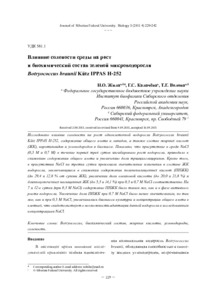Влияние солености среды на рост и биохимический состав зеленой микроводоросли Botryococcus braunii Kütz IPPAS H-252
Скачать файл:
URI (для ссылок/цитирований):
https://elib.sfu-kras.ru/handle/2311/2724Автор:
Жила, Н.О.
Zhila, Natalia O.
Калачёва, Г.С.
Kalachova, Galina S.
Волова, Т.Г.
Volova, Tatiana G.
Дата:
2011-09Аннотация:
Исследовано влияние солености на рост одноклеточной водоросли Botryococcus braunii
Kütz IPPAS H-252, содержание общего азота и липидов, а также состав жирных кислот
(ЖК), каротиноидов и углеводородов в биомассе. Показано, что присутствие в среде NaCl
(0,3 М и 0,7 M) в течение первых трех суток ингибировало рост водоросли, приводило к
снижению содержания общего азота и увеличению доли триацилглицеринов. Кроме того,
в присутствии NaCl на третьи сутки произошли значительные изменения в составе ЖК
водоросли, заключающиеся в снижении содержания полиненасыщенных кислот (ПНЖК)
(до 29,4 и 12,8 % от суммы ЖК), увеличении доли олеиновой кислоты (до 20,0 и 21,8 %) и
длинноцепочечных насыщенных ЖК (до 5,3 и 14,1 %) при 0,3 и 0,7 M NaCl соответственно. На
7 и 12-е сутки (при 0,3 M NaCl) содержание ПНЖК было таким же, как и в фазе активного
роста водоросли. Увеличение доли ПНЖК при 0,7 M NaCl было менее значительным, но так
же, как и при 0,3 M NaCl, увеличивались биомасса культуры и концентрация общего азота в
клетках, что свидетельствует о возможности адаптации данной водоросли к исследованным
концентрациям NaCl. The effect of 0,3 and 0,7 M NaCl on biomass yield, total nitrogen content, intracellular lipid content,
hydrocarbons and fatty acid profile of the lipids of the alga Botryococcus braunii Kütz IPPAS H-252
in different phases of the culture cycle was studied. The presence of sodium chloride in the medium inhibited the growth of algal cells for the first three days of the experiment, causing a decrease in
total nitrogen, enhanced synthesis of triacylglycerols. In addition, considerable changes in the lipid
fatty acid profile were found, i.e. decrease in polyunsaturated fatty acid (PUFA) levels (29,38 % and
12,8 %) and levels of long-chain saturated acids (5,3 % and 14,13 % of the total) at 0,3 M NaCl and
0,7 M NaCl, respectively. In later phases of the culture, at 0,3 M NaCl, the PUFA content increased
up to the values characteristic of the active growth phase of the alga. At 0,7 M NaCl, the proportion
of PUFA enhanced at less extent, but biomass concentration and total nitrogen increased, similarly
to the experiment with 0,3 M NaCl, that may also be indicative of adaptation of the alga to the studied
concentrations of NaCl.

